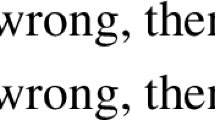Abstract
Data from surprising sloppy readings of verb phrase ellipsis constructions argue that ellipsis sites can partially or totally consist of dynamically bound pro-forms. I give an account, integrating Muskens’ CDRT with a focus-based theory of ellipsis and deaccenting.
Thanks to Mark Baltin, Chris Barker, Daniel Hardt, Irene Heim, Kyle Johnson, Salvador Mascarenhas, Philippe Schlenker, Mike Solomon, and Anna Szabolcsi. I was supported by an NSF Graduate Research Fellowship and NSF grant BCS-0902671.
Access this chapter
Tax calculation will be finalised at checkout
Purchases are for personal use only
Preview
Unable to display preview. Download preview PDF.
Similar content being viewed by others
References
Bos, J.: Focusing Particles & Ellipsis Resolution. Verbmobil Report 61, Universitat des Saarlandes (1994)
Elbourne, P.: E-type anaphora as NP deletion. Natural Language Semantics 9(3), 241–288 (2001)
Evans, F.: Binding into Anaphoric Verb Phrases. In: Proceedings of ESCOL (1988)
Fiengo, R., May, R.: Indices and identity. MIT Press, Cambridge (1994)
Hardt, D.: Dynamic interpretation of verb phrase ellipsis. Linguistics and Philosophy 22(2), 185–219 (1999)
Heim, I.: Predicates or formulas? Evidence from ellipsis. In: Lawson, A., Cho, E. (eds.) Proceedings of SALT 7, pp. 19–221 (1997)
Hendriks, H.: Studied Flexibility. ILLC Dissertation Series, Amsterdam (1993)
Keenan, E.: Names, quantifiers, and the sloppy identity problem. Papers in Linguistics 4(2), 211–232 (1971)
Kratzer, A.: The Representation of Focus. In: von Stechow, A., Wunderlich, D. (eds.) Semantics: An International Handbook of Contemporary Research, pp. 825–832. de Gruyter, Berlin (1991)
Merchant, J.: Antecedent Contained Deletion in Negative Polarity Items. Syntax 3, 144–150 (2000)
Muskens, R.: Combining Montague Semantics and Discourse Representation. Linguistics and Philosophy 19, 143–186 (1996)
Reinhart, T.: Anaphora and Semantic Interpretation. U. of Chicago Press (1983)
Rooth, M.: Association with Focus. UMass, Amherst dissertation (1985)
Rooth, M.: Ellipsis redundancy and reduction redundancy. In: Berman, S., Hestvik, A. (eds.) Proceedings of the Stuttgart Ellipsis Workshop, Stuttgart (1992a)
Rooth, M.: A Theory of Focus Interpretation. Natural Language Semantics 1, 75–116 (1992b)
Rooth, M., Partee, B.: Conjunction, type ambiguity, and wide scope “or”. In: Flickinger, D., et al. (eds.) Proceedings of the First West Coast Conference on Formal Linguistics, pp. 353–362. Stanford University (1982)
Sag, I.: Deletion and Logical Form. MIT dissertation (1976)
Sauerland, U.: Copying vs. structure sharing: a semantic argument. In: van Craenenbroeck, J. (ed.) Linguistic Variation Yearbook, vol. 7, pp. 27–51. John Benjamins Publishing Company (2007)
Schwarz, B.: Topics in Ellipsis. UMass, Amherst dissertation (2000)
Stone, M.: Or and anaphora. In: Proceedings of SALT 2, pp. 367–385 (1992)
Stone, M., Hardt, D.: Dynamic discourse referents for tense and modals. In: Bunt, H. (ed.) Computational Semantics, pp. 287–299. Kluwer (1999)
Tomioka, S.: A sloppy identity puzzle. Natural Language Semantics 7(2), 217–241 (1999)
Tomioka, S.: A step-by-step guide to ellipsis resolution. In: Johnson, K. (ed.) Topics in Ellipsis, pp. 210–228. Cambridge University Press (2008)
Wescoat, M.: Sloppy Readings with Embedded Antecedents. Stanford ms. (1989)
Williams, E.: Discourse and logical form. Linguistic Inquiry 8, 101–139 (1977)
Author information
Authors and Affiliations
Editor information
Editors and Affiliations
Rights and permissions
Copyright information
© 2012 Springer-Verlag Berlin Heidelberg
About this paper
Cite this paper
Charlow, S. (2012). Cross-Categorial Donkeys. In: Aloni, M., Kimmelman, V., Roelofsen, F., Sassoon, G.W., Schulz, K., Westera, M. (eds) Logic, Language and Meaning. Lecture Notes in Computer Science, vol 7218. Springer, Berlin, Heidelberg. https://doi.org/10.1007/978-3-642-31482-7_27
Download citation
DOI: https://doi.org/10.1007/978-3-642-31482-7_27
Publisher Name: Springer, Berlin, Heidelberg
Print ISBN: 978-3-642-31481-0
Online ISBN: 978-3-642-31482-7
eBook Packages: Computer ScienceComputer Science (R0)




